
The Tangut people were a Tibeto-Burman tribal union that inhabited Western Xia. The group lived under Tuyuhun authority and moved to Northwest China sometime before the 10th century to found the Western Xia or Tangut Empire (1038–1227). They spoke the Tangut language, which was previously believed to be one of the Qiangic languages or Yi languages that belong to the Tibeto-Burman family. Recent phylogenetic and historical linguistic accounts, however, reveal that Tangut belonged to the Gyalrongic languages.

Lokapāla, Sanskrit and Pāli for "guardian of the world", has different uses depending on whether it is found in a Hindu or Buddhist context.

Padmasambhava, also known as Guru Rinpoche and the Lotus from Oḍḍiyāna, was an tantric Buddhist Vajra master from India who may have taught Vajrayana in Tibet. According to some early Tibetan sources like the Testament of Ba, he came to Tibet in the 8th century and helped construct Samye Monastery, the first Buddhist monastery in Tibet. However, little is known about the actual historical figure other than his ties to Vajrayana.

Bon, also spelled Bön is considered to be the native pre-Buddhist religious tradition of Tibet. A distinction is sometimes made between:
- the Old Bon or Bön nying, dating back to the pre-dynastic era;
- the Eternal Bon or Yungdrung Bön, the classical Bon tradition ; and
- the New Bon or Bonsar, a late syncretic movement dating back to the 14th century and active in eastern Tibet.

In Buddhism, wrathful deities or fierce deities are the fierce, wrathful or forceful forms of enlightened Buddhas, Bodhisattvas or Devas. Because of their power to destroy the obstacles to enlightenment, they are also termed krodha-vighnantaka, "Wrathful onlookers on destroying obstacles". Wrathful deities are a notable feature of the iconography of Mahayana and Vajrayana Buddhism. These types of deities first appeared in India during the late 6th century with its main source being the Yaksha imagery and became a central feature of Indian Tantric Buddhism by the late 10th or early 11th century.
A dharmapāla is a type of wrathful god in Buddhism. The name means "dharma protector" in Sanskrit, and the dharmapālas are also known as the Defenders of the Justice (Dharma), or the Guardians of the Law. There are two kinds of dharmapala, Worldly Guardians (lokapala) and Wisdom Protectors (jnanapala). Only Wisdom Protectors are enlightened beings.

Samye, full name Samye Mighur Lhundrub Tsula Khang and Shrine of Unchanging Spontaneous Presence is the first Tibetan Buddhist and Nyingma monastery built in Tibet, during the reign of King Trisong Deutsen. Shantarakshita began construction around 763, and Vajrayana founder Guru Padmasambhava tamed the local spirits for its completion in 779. The first Tibetan monks were ordained there. Samye was destroyed during the Cultural Revolution then rebuilt after 1988.
Yidam is a type of deity associated with tantric or Vajrayana Buddhism said to be manifestations of Buddhahood or enlightened mind. During personal meditation (sādhana) practice, the yogi identifies their own form, attributes and mind with those of a yidam for the purpose of transformation. Yidam is sometimes translated by the terms "meditational deity" or "tutelary deity". Examples of yidams include the meditation deities Chakrasamvara, Kalachakra, Hevajra, Yamantaka, and Vajrayogini, all of whom have a distinctive iconography, mandala, mantra, rites of invocation and practice.
Losar also known as Tibetan New Year, is a festival in Tibetan Buddhism. The holiday is celebrated on various dates depending on location tradition. The holiday is a new year's festival, celebrated on the first day of the lunisolar Tibetan calendar, which corresponds to a date in February or March in the Gregorian calendar. In 2020, the new year commenced on the 24th of February and celebrations ran until the 26th of the same month. It also commenced the Year of the Male Iron Rat.
The Dorje Shugden controversy is a controversy over Dorje Shugden, also known as Dolgyal, who some consider to be one of several protectors of the Gelug school, the school of Tibetan Buddhism to which the Dalai Lamas belong. Dorje Shugden has become the symbolic centre-point of a conflict over the "purity" of the Gelug school and the inclusion of non-Gelug teachings, especially Nyingma ones.

Dorje Shugden, also known as Dolgyal and as Gyalchen Shugden, is an entity associated with the Gelug school, the newest of the schools of Tibetan Buddhism. Dorje Shugden is variously looked upon as a destroyed gyalpo, a minor mundane protector, a major mundane protector, an enlightened major protector whose outward appearance is that of a gyalpo, or as an enlightened major protector whose outward appearance is enlightened.

Ngawang Lobsang Gyatso was the 5th Dalai Lama and the first Dalai Lama to wield effective temporal and spiritual power over all Tibet. He is often referred to simply as the Great Fifth, being a key religious and temporal leader of Tibetan Buddhism and Tibet. Gyatso is credited with unifying all Tibet under the Ganden Phodrang after a Mongol military intervention which ended a protracted era of civil wars. As an independent head of state, he established relations with Qing Empire and other regional countries and also met early European explorers. Gyatso also wrote 24 volumes' worth of scholarly and religious works on a wide range of subjects.
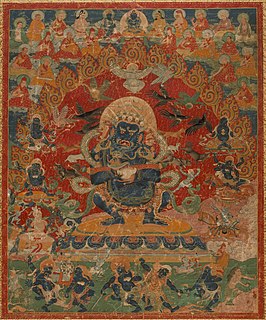
Mahākāla is a deity common to Hinduism and Tantric Buddhism. In both religions, Mahākāla is a fierce manifestation of Shiva and is the consort of the goddess Mahākālī; he most prominently appears in the Kalikula sect of Shaktism. Mahākāla also appears as a protector deity known as a dharmapala in Vajrayana, Chinese Esoteric, and Tibetan Buddhism, and also in the Chàn and Shingon traditions. He is known as Dàhēitiān and Daaih'hāktīn in Mandarin and Cantonese, Daeheukcheon (대흑천) in Korean, Đại Hắc Thiên in Vietnamese, and Daikokuten in Japanese.
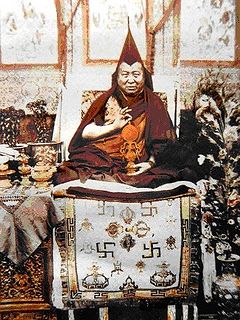
Pabongkhapa Déchen Nyingpo, (1878–1941) was a Gelug lama of the modern era of Tibetan Buddhism. He attained his Geshe degree at Sera Mey Monastic University, Lhasa, and became a highly influential teacher in Tibet, unusual for teaching a great number of lay people. Pabongkha was offered the regency of the present Dalai Lama but declined the request because "he strongly disliked political affairs."
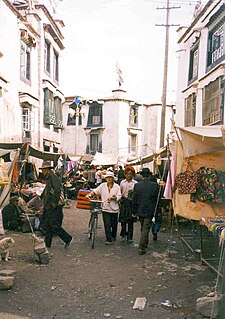
Muru Ningba or Meru Nyingba is a small Buddhist monastery located between the larger monasteries of Jokhang and Barkhor in the city of Lhasa, Tibet, China. It was the Lhasa seat of the former State Oracle who had his main residence at Nechung Monastery.
The Tenma goddesses are twelve guardian deities in Tibetan Buddhism. In hierarchy, they fall under Palden Lhamo, one of the eight Dharmapala deities. Other times, they are part of the retinue of the Bönpo goddess, Sidpa Gyalmo. Formerly, the 12 Tenma were said to have been local protectors of Tibet before the spread of Buddhism until they came to Padmasambhava's Asura Cave in the Pharping region of Nepal while Padmasambhava was subduing many deities and spirits. Some stories say that the goddesses were hostile to the spread of Buddhism during this time while others said that they refused to give their life essence to Padmasambhava and wanted to keep protecting Tibet. Either ways, Padmasabhava defeated them and bound them to an oath to protect the dharma.
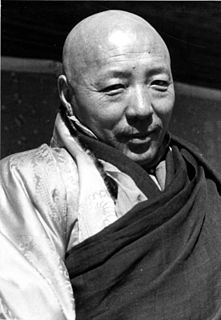
The Nechung Oracle is the State Oracle of Tibet. The medium of the State Oracle currently resides with the current Dalai Lama in Dharamsala, India. Prior to the Himalayan diaspora resulting from the annexation of Tibet by the People's Republic of China, the Nechung Oracle was the designated head of the Nechung monastery in Tibet.
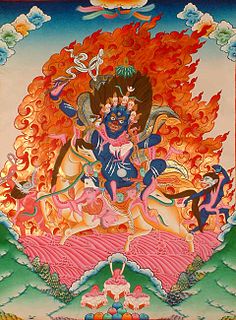
Palden Lhamo or Remati are all forms of Shri Devi a category of female tantric buddhist deity who appears in dozens of different forms. She usually appears as a wrathful deity with a primary role as a dharmapala. She is specifically a Wisdom Protector, an enlightened being.

Nechung Monastery, Nechung Gompa or Nechung Chok, is the seat of the State Oracle of Tibet. It is also referred to as Sungi Gyelpoi Tsenkar, the "Demon Fortress of the Oracle King."
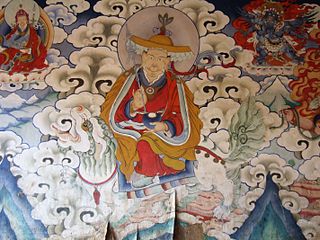
Gyalpo spirits are one of the eight classes of haughty gods and spirits in Tibetan mythology and religion. Gyalpo, a word which simply means "king" in the Tibetic languages, in Tibetan mythology is used to refer to the Four Heavenly Kings and especially to a class of spirits, both Buddhist and Bon, who may be either malevolent spirits or oath-bound as dharmapalas.















